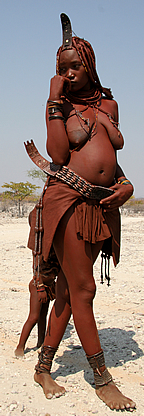History & Culture of Namibia
History
 The wild and barren western quarter of Southern Africa was a vast region missed by the great Bantu Migration that populated much of Africa, including almost all of Southern Africa, with people of west and central African origin. This process caused the displacement over centuries of the original inhabitants of southern Africa, who were of a much older branch of humanity than the Bantu, and included among them the Bushmen, the Khoi-khoi, the Damara and Namaqua.
The wild and barren western quarter of Southern Africa was a vast region missed by the great Bantu Migration that populated much of Africa, including almost all of Southern Africa, with people of west and central African origin. This process caused the displacement over centuries of the original inhabitants of southern Africa, who were of a much older branch of humanity than the Bantu, and included among them the Bushmen, the Khoi-khoi, the Damara and Namaqua.
The Herero People, however, who are of Bantu origin, entered Namibia in about the 17th and 18th centuries, but did not wholly displace or annihilate the indigenous inhabitants as had been the case almost everywhere else. Later came the Portuguese, who, edging down the west coast of Africa in search of a through passage to India, briefly visited the west coast before rounding the cape in 1488 and containing east to the Indies.
Permeate white settlement did not occur until the Germans laid claim to the territory. This occurred in the late 19th century as most of the old world powers began to accelerate their interest in imperial expansion in Africa. The Berlin Conference of 1885, a gathering of all the imperial powers of Europe, was convened to establishes the ground rules of African partition. This effectively fired the starting gun that set in motion the Scramble for Africa.
Over the course of the next decade virtually no square inch of Africa escaped claim by one or other of the European powers, and the vast area now demarcated as Namibia became the territory first of German Damaraland, and then German South West Africa  this was excepting Walvis Bay which remained under British Control until independence.
A war was fought between the Herero with an alliance of Namaqua against the German occupying force between 1904 and 1907. This resulted in a catastrophic defeat of the native alliance and subsequent genocidal persecution of the Namaqua/Hereo at the cost of more than half of their surviving population. Death by starvation and the poisoning of wells gave this, the first genocide of the 20th century, a particularly grim character.
The Germans were not able to hold onto the territory for very long, however, and were defeated by a British force under the command of Generals Louis Both and Jan Smuts during WWI, after which the territory was mandated to South Africa, and became in effect a South African colony.
The liberation period began in 1966 with the formation of the South West African Peoples Organization, or SWAPO, under the leadership of the charismatic Sam Nujoma, who lead a 22 year guerrilla war against South Africa, culminating in independence and majority rule in 1990.
Culture
 As a society Namibia remains deeply affected by historical events relating to colonial occupation, the war of independence, and aspects of unfinished business such as land distribution and the treatment and fate of the Hereo and Namqua people. Palpable tensions remain across the ethnic and race divides, which are not confined to black and white, but include a kaleidoscope of color and race variants that remain as something of an overspill from all the neighboring colonial experiences, most notably South African.
As a society Namibia remains deeply affected by historical events relating to colonial occupation, the war of independence, and aspects of unfinished business such as land distribution and the treatment and fate of the Hereo and Namqua people. Palpable tensions remain across the ethnic and race divides, which are not confined to black and white, but include a kaleidoscope of color and race variants that remain as something of an overspill from all the neighboring colonial experiences, most notably South African.
Afrikaans tends to be the lingua franca of Namibia, with most whites and people of mixed race propagating Afrikaans culture, which, bearing in mind the wider race dynamic and history in the region, has limited appeal for the majority.
While Afrikaans is the most widely spoken language, the most commonly spoken is Oshivambo, the language of the Ovambo people, a Bantu group comprising the largest language group in the country. Bantu groups now constitute a majority, and among these are the Herero and Himba groups. Both of these maintain strong traditional ties, with the Himba in particularly living in a manner largely unaltered by modernity. People of Khoisan ethnicity are also well represented in Namibia, with Bushmen and Namaqua being the most conspicuous of these.
Another large group is the Baster, a mixed-race community of South African origin who migrated north from the Cape Colony in mid-19th century in search of land, and settled in central Namibia where many still remain.
The white community is mixed, with influences of Angolan Portuguese, South Africa, French, British and of course German. The white population comprises about 6 percent, and is the largest permanently settled white population in sub-Saharan Africa after South Africa.